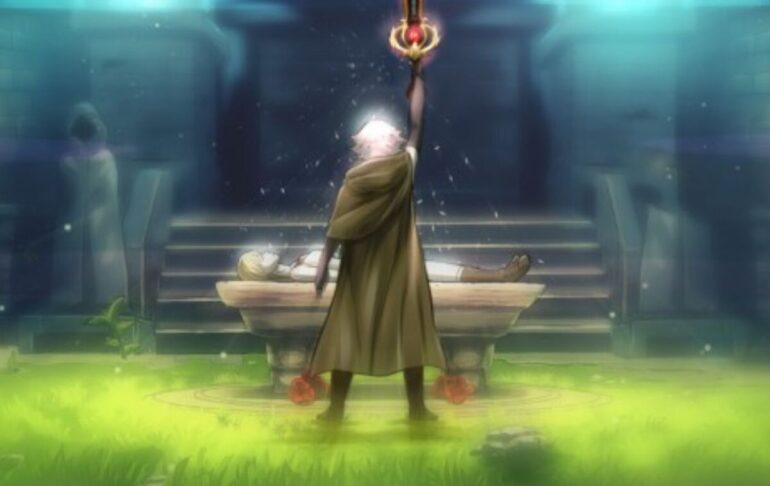I must admit that I’m far from the best at roguelike games. The only one that I ever beat was a game called Azure Dreams on the PlayStation 1, which came out in 1997 before the genre was even properly named “roguelike”. However, it was nowhere near as hard as some of the ones that come out today. Sometimes in modern roguelikes, a bad case of RNG can make or break your run, so I mostly shy away from such games. They’re not bad games — I am just bad at them. That said, I was very surprised at how much I’ve been enjoying Sword of the Necromancer with its easily approachable gameplay for all skill levels, and the bittersweet tone of its narrative.
The story starts with seemingly a small amount of context, as you play as a mercenary named Tama, carrying the body of a priestess named Koko into a crypt that contains the Sword of the Necromancer. Tama hopes to use its power to eventually bring Koko’s soul back to her body to fully resurrect her. Tama is desperate and full of such deep pain and that is conveyed perfectly here. You get cutscenes depicting the history of Tama and Koko as you progress in between floors in the form of flashbacks and inner monologues from the main character. These range from where and when they first met, why they were traveling together, and watching their budding love grow until Koko’s tragic death. I like this style of storytelling and Sword of the Necromancer performs it perfectly.
The gameplay is what you would expect from a roguelike, running and fighting enemies as you find weapons and armor, but with a catch: the Sword of the Necromancer — your starting weapon — has the ability to resurrect any enemy you defeat. This can help greatly as the many monster types can fill gaps in your builds. Couple this with its smooth and precise controls and gameplay feels fair and balanced. I always felt that every time I died, it was my fault instead of fighting with clunky controls.
Another one of its core features is local cooperative play through the use of a homunculus item you get at the start of the game. This was a selling point to me since I was looking for a game my wife and I can play together. The homunculus (player two) can also help alleviate a bit of the difficulty curve but not in such a way that it can break the game. The homunculus can’t resurrect monsters since player one only has the Sword of the Necromancer and starts with just a basic weapon, but can use other items like swords, shields, and attribute boosting trinkets.
The graphics are beautifully presented in a detailed 32-bit style with smooth animations and spell effects that make the art style pop. I also like the pseudo-anime style of the main characters and they translate well from the drawn still shots in cutscenes to the pixelated sprites during gameplay. Monster designs are also interesting and not like the standard “bat” or “skeleton” type — flying eyes, hollow and headless armor, and empty cloaks that cast spells, to name a few. The randomized dungeons keep things interesting too, changing the aesthetics from floor to floor and giving hints to the enemy types you’re most likely to encounter. If there’s grass and moss everywhere, you know you’ll need fire-type abilities or fire attributed monsters collected to be resurrected. This is a well-thought out bit of design from the developers, one of many small details that bring the game to life.
The music is also a highlight, using a moody ambiance both in and out of combat to set a more subdued mood. It trades the anxiety-inducing tunes I hear in other roguelikes to make it seem just a bit more relaxed and keeps your mind a bit more focused when handling the waves of enemies. Just watching a friend play Binding of Issac puts me on the edge of my seat and I can’t even imagine playing and making any sort of progress in that game—not that I think that’s a bad thing, but this isn’t what Sword of the Necromancer is trying for. The music works very well to convey a tone of subdued determination that keeps you going further to your goal.
Another thing that softens this game compared to other roguelikes is its adjustable difficulty. They can be made as hard or as forgiving as you want through many settings outside of just the typical “normal, easy, and hard” settings. You can adjust if you want to drop items on death, keep experience if you leave the dungeon to the hub, and even if you wish to start on the floor before the boss you have to beat. This makes Sword of the Necromancer pretty approachable to people like me who aren’t used to games of this genre or those who just want to take in the story and learn the enemy patterns before they tackle the game properly. This isn’t listed as a feature on the Steam or Switch store pages, but it should be. I’ve never seen this level of customization in difficulty in a roguelike game — or any game, for that matter.
I feel like Sword of the Necromancer flew under the radar and is a hidden gem. It checks off many points to make itself a truly great indie roguelike game that deserves a download. It doesn’t disappoint in any aspect of its gameplay, art style, sound design, voice acting, or story. I highly recommend Sword of the Necromancer to anyone — even to those that aren’t that big into the roguelike genre.
READ NEXT: Is Returnal Really That Hard?
Some of the coverage you find on Cultured Vultures contains affiliate links, which provide us with small commissions based on purchases made from visiting our site.

